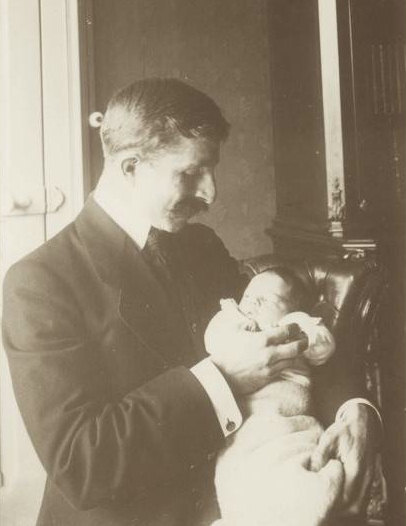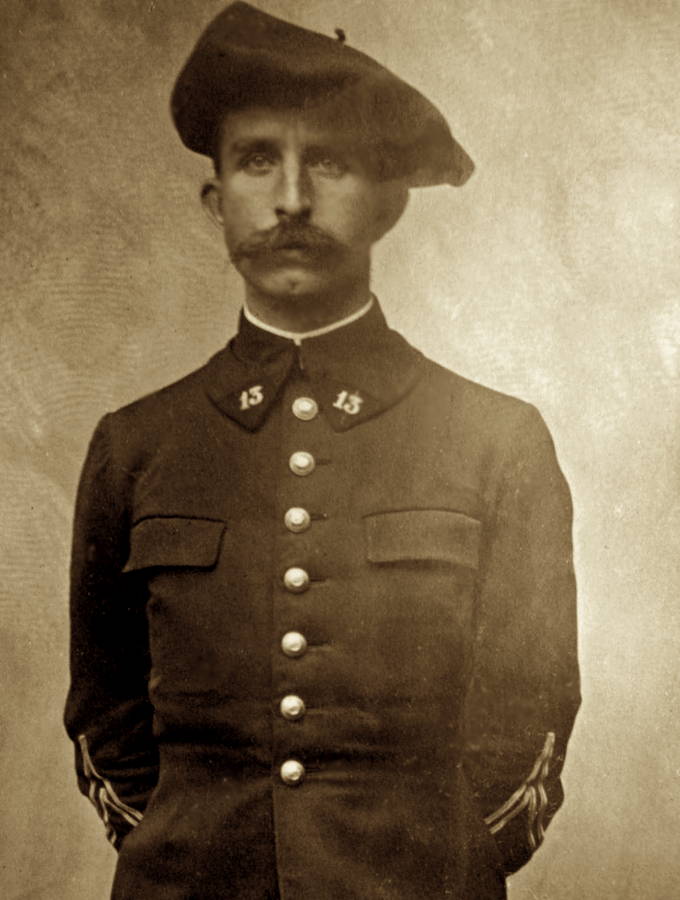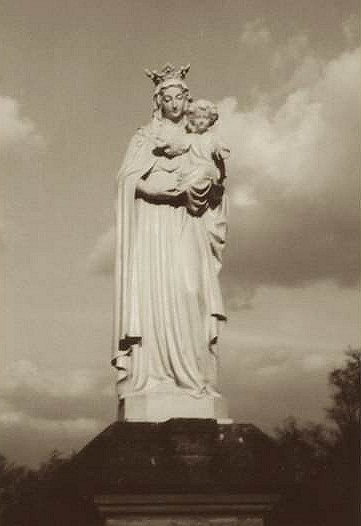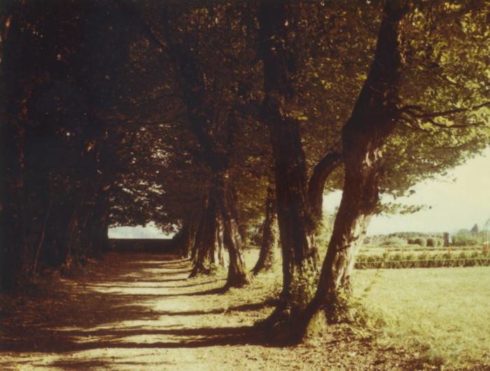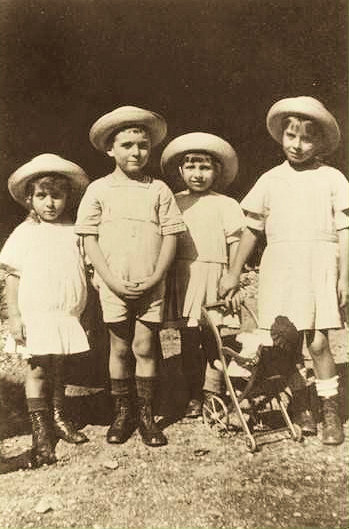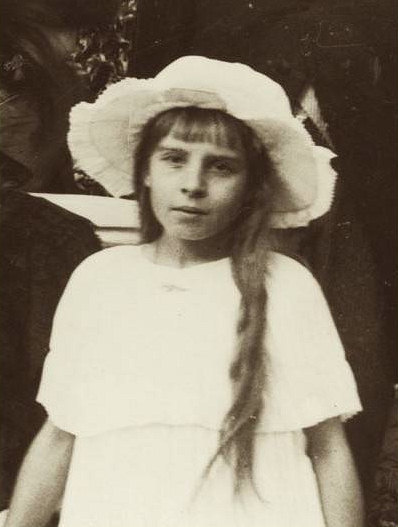Ven. Anne de Guigné
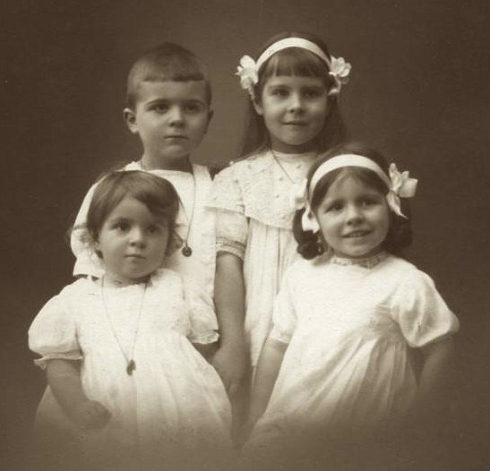
Left front is Marie-Antoinette and next to her is Magdeleine. Back is Jacques and Anne, who is eight years old.
When St. Thomas Aquinas’s sister asked him how to become a Saint, he told her to just “will it.” Venerable Anne de Guigné¹ was a child with an iron will and from the moment of her conversion, she willed only one thing…to be a Saint. “To become a Saint is to persist,” she said. Though she lived for a short time, she excelled in overcoming her natural inclinations, generously and heroically accepted the sufferings that God sent to her.
Ven. Anne de Guigné, the eldest of four children was born on April 25, 1911 to Count Jacques de Guigné and Antoinette de Charette. The Count was a second lieutenant in the 13th Battalion, Chambéry of Chasseurs Alpins. Anne’s maternal grandmother, Francoise Eulalie Marie Madeleine de Bourbon-Busset was a direct descendant of the sixth son of King St. Louis IX of France. Anne’s Mother was the great-niece of General François de Charette, one of La Vendée leaders.
Ven. Anne died when she was 10 years old, though short, it was full of suffering and joy, but she wasn’t saintly at first; in fact she was a little tyrant. One doctor, who came to visit the child who was very ill, found it impossible to examine her and a furious command came from Anne, “Take your hat and go!” Such scenes were not unusual. Her grandfather said once, “I feel sorry for her Mother 20 years from now.” Anne was intelligent, perfectly frank, courageous and when she wasn’t being troublesome, she could be very loving. Though if anyone showed resistance to what she wanted to do, there was trouble!
When Jacques (Jojo) was born 15 months after Anne, she became very jealous, throwing dirt in the baby’s eyes and she even kicked him once. Thankfully it didn’t last long and she was very happy to be the oldest. Anne was haughty, vain difficult to handle and her first 4 years were the worst. This behavior was soon to change and with it a saintly, little girl emerged.
In September 1913, Magdeleine was born and January 1915 Marie-Antoinette was born. Anne was the Godmother of Marie-Antoinette³, who everyone called Marinette. When Anne was 3 ½ the war broke out between France and Germany and her father, though retired, was sent to the front lines. A month later he returned home, severely injured. Anne, who loved her father immensely, took upon herself to look after him, fetching books and even arranging his cushions. Recovering from his wounds, Lieutenant de Guigné left again for the front lines only to return a few days later wounded worse than before. Despite not being healed sufficiently, Lieutenant de Guigné insisted upon returning to his men. In February, being seriously wounded, he was sent to a hospital in Lyons for an operation. Taking Anne with her, Madame de Guigné went to Lyons and pointed out the suffering soldiers to Anne, who was moved at the sight.
On May 3, Feast of the Holy Cross, feeling better the Count left again for the front line. The Germans, who had invaded France, were trying to take Paris. In Alsace, on July 22, 1915, Lieutenant de Guigné, having received absolution, led the attack with his men. With a large sign of the cross and charging from the trenches, Lieutenant de Guigné was killed. The news of his death was delivered to his wife on July 28th. In the morning, the grieving widow told Anne about her father’s death. Tearfully Madame de Guigné said to Anne, “If you want to comfort me, you must be good.” Gazing long and thoughtfully into her Mother’s eyes, she realized that in order to please God she must be good and Anne resolved to be good and please her Mother. Her father’s death was the beginning of Anne’s conversion. All day long, Anne was thoughtful, trying to make the other children behave. “You must be good Jojo, because Mother is sad.” From this time on there was no more tempers, nor selfishness. This huge change did not come easy for Anne; though no one would have guessed the daily battle within herself she fought.

Anne aged two and a half, 1913. “When very small, before the age of four, obedience was very difficult for her. She used to resist violently. From the time of her conversion, however, she started to control herself and achieved unquestioning obedience which cost her a great deal,” Madame de Guigné.
When Madeleine Bassett (Demoise as the children called her), the governess came in January 1916, she was surprised to hear how difficult Anne had been for the past 4 ½ years. Anne fussed over Demoise, so as to make her feel at home, even pointing to the flowers in the garden, telling Demoise that she can send a bouquet to her family back home in Cannes. One thing that the governess noticed was that Anne seemed wise beyond her years. “I was really charmed by the easy grace of her manner. One could not help loving her even then that inspired respect. She was very sensible too, and she had such a kind little heart.”
Shortly before Anne’s conversion, Madeleine Bassett found Anne standing on a chair surveying her reflection in the mirror with some satisfaction. “I’m rather pretty, don’t you think so,” said the four-year-old. The governess replied that it was a waste of time to admire yourself, since beauty is a gift of God and we should not be vain about it. Anne jumped down from the chair and never praised herself again.

Jacques, Magdeleine on the cushion, Anne, and Marie-Antoinette on Madame de Guigné’s lap, May 3rd, 1915. “From the age of four until her death, her striving for perfection never faltered. There was nothing spectacular, no amazing facts but everything she did was inspired by the Holy Ghost and she put all her love into it,” Madame de Guigné.
A month before her father was killed, Anne talked about preparing for her First Holy Communion, so in the autumn of 1915, Madame de Guigné enrolled Anne in the catechism class taught by Mother St. Raymond at the Auxiliatrice Convent. Mother St. Raymond perceived that Anne, though only 5 years old, was far advance than all the rest. “I soon saw that Anne was a very gifted child; but what struck me most was this: the others were never jealous of her, though she was cleverer than any of them and the youngest. Every one of them loved and admired her. I think it was because she never tried to ‘show off’ or get the better of anyone. Her manner was so sweet too. She was as nice with some rather spoiled children as with those who behaved well. Not only did I never hear her say an unkind word, but she never even teased the other children, and this must have meant considerable self-control, for she was naturally so quick and sharp. At first she had a little difficulty in learning by heart, so I told her to repeat in her own words all she had understood of the day’s lesson. It was about the Church, a difficult subject for a small child, and I did not expect much; but to my great surprise she had understood it all and repeated the whole lesson in astonishingly clear and precise words. It often seemed as if God must have taught her.”
One time when Anne was 4 years old, she was walking with her grandfather and they passed by a store of wheat. Her grandfather asked her: “Anne, do you know what is done with wheat?” Anne answered, “Tell me, Grandpa.”
“The farmer gathers the wheat and then grinds it and then makes flour for us. We use this flour to make bread and also to make the Hosts that the priest gives us at Mass. Do you know what the Hosts become?”
Anne responded, “Little Jesus comes and hides Himself in the white Hosts, which become Jesus.”
A priest asked Anne where the Holy Ghost dwelt specially. “In the souls of the just,” came the quick response. No one remembered teaching her that. “She listened eagerly to all I said,” Mother St. Raymond continues, “but she never tried to answer out of her turn, or in fact until she was questioned; but very often all heads would turn in her direction when nobody knew the lesson ― and they were not mistaken. ‘This little girl knows everything!’ a 9 year old once said.”

Jacques, Magdeleine, the Governess Mlle Madeleine Basset, Anne and Marinette who must have moved. “It was she [Anne] who taught me what loving God meant. The secrets of her spiritual growth were prayer and willpower.” (Mademoiselle Basset)
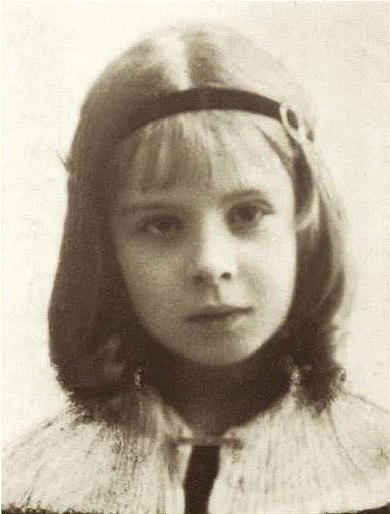
Anne, almost nine. “I asked her ‘Do you love God?’ She answered me with such intensity in her eyes and her whole body: ‘Father, I love Him with all my heart and soul!’ I have never forgotten the ardour of the love that she radiated,” Father Jacquemont.
The learned Jesuit questioned Anne with a series of random questions and quickly became convinced that she was perfectly prepared. He became so interested in her that he prolonged the interview for some time, questioning her on all sorts of subjects and even probing Anne’s conscience.
“What is your chief fault?” he asked.
“Pride,” Anne promptly answered, “and disobedience too.”
Humility there, thought the priest, but he pretended to be very stern and told her that a little girl who wanted to receive Our Lord must obey at once. Then he quickly asked her: “When does Jesus obey?”
“At Mass,” Anne quickly responded.
“What words does He obey?”
“He obeys the priest when he says: ‘This is My Body, this is My Blood.’”
Finally the interview was over and both the Superior and Anne emerged, smiling, much to everyone’s great relief. “I wish you and I were as well prepared to receive Our Lord as this little girl is,” the Superior said. All obstacles being now removed, Anne joined the First Communicants’ retreat at the Convent. The theme being, “Obedience is the sanctity of children” which Anne took to heart and for her to know was to act, so it was done. From that time forth, she was practically perfect in obedience. “You must offer everything to our good Jesus. I want my heart to be as pure as a lily for Jesus,” Anne said.
When Anne made her First Holy Communion, it was March 26, 1917, a Monday in Passion Week and the feast of Our Lady’s Annunciation, which had been transferred to the 26th since the 25th fell on Passion Sunday. Her First Communion resolution was: “I will give my sacrifices to Mary, so that She may give them to Jesus.” She was never known to refuse a sacrifice. That day, Anne wrote: “My Jesus, I love You and to please You, I resolve to obey You always.” Anne had a great devotion to Our Lady and Our Lady of Sorrows for her was “Our Lady of Consolation,” and this was the title she gave to a little statue in the garden, near where the children played. Here she would go to beg for help when the struggle for self-control became very hard.
Once, when asked by Sister Germaine, what her greatest happiness on earth is, Anne said, “My greatest happiness is to suffer much for our gracious God.” Any suffering she would endure Anne would immediately offer it up, saying: “Jesus, I offer it to you.” Once Mother St. Raymond asked Anne which would be best, to die old or young? “A long life is a blessing because it permits you to suffer much for Jesus,” Anne replied. Anne would often say when she saw anyone worrying: “Why fret about things? God is there. If He allows it, surely it must be good for us.”
Anne constantly remembered to make sacrifices but when she was “taking care of a sinner” she increased them. She never shied away from a sacrifice and she gave each one of these sacrifices to Our Lady, so that She might present them to Our Lord. At one time, Anne learned that a very ill man had not gone to church from the time he had made his First Communion. He wanted to die that way, for he would not even look at the face of a priest. Anne resolved to win that soul back to God. She went to Mass with her mother and she prayed for this man. Later in the morning, she went back to the church again. She knew it was going to be hard to win this soul. “Mother, has he gone to confession yet?” she asked. “Come, let us pray again.” They went back to the church a third, a fourth, and a fifth time to pray that day. The next morning, Anne heard the good news: her sinner had received the Last Sacraments.
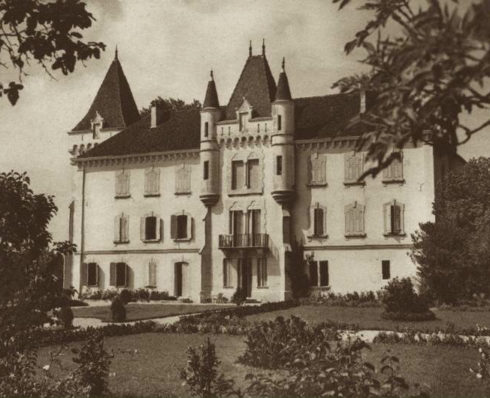
The family Chateau de La Cour, which overlooked the Lake of Annecy. “I live in a château too, and it’s even the most beautiful in the country,” Anne once said. The family lived here for most of the time till they went to their winter home in Cannes.
When she was ten years old, she resolved to imitate Our Lord in everything: “How will I go about it? By combating all the obstacles that keep Jesus from growing inside me: my faults, this pride of mine, my laziness… It is going to be a daily battle.” She made these three resolutions: “I must have: 1) cleanliness (of soul); 2) appropriate clothing; 3) ornamentation ― the good actions we do of our own accord (supererogatory works). Anne wrote: “My soul is destined for Heaven. People are very preoccupied with their outward appearance and hardly at all with the soul . . . My soul was made for eternal life, to be infinitely happy or infinitely unhappy. The good Lord wants it to be eternally happy. That depends on me alone. Mamma cannot do that work for me.”
“If my body needs food, I must also provide food for the life of my soul. What is this food? All which is true, beautiful and good, all the things which I have learned from my Mother. In order to increase the life Jesus inside me, I must bring food to my soul often, very often. The life of grace is most precious, and its nourishment is Jesus Christ, Himself, that’s why we must desire it with all our hearts…I want to receive Communion as often as possible.”
Once Anne saw a poor old man walking in the distance and she asked the governess for some money, since she didn’t have any in her purse. Smiling, Anne ran to give the man the money, who in turn thanked her, saying that a holy child had given him the alms. Another time, a fire destroyed a poor house nearby and Anne, hearing that the widow and children were without a home, asked her Mother if they could hold a bazaar. The four children made tea sets out of acorns, shelves for the display and desserts for the ‘tea set’ and sold, as Anne said, “at a very expensive price, since it is for charity.” The ‘customers’ were Mother, Grandpa and Aunt Paula, who were happy to pay, which the de Guigné children happily took the proceeds to the widowed family.
Anne’s charity to her ‘dear little poor’ was endless. She would knit and if she thought it didn’t look right, she would rip it out and start all over again. She would select from her toys, ones that she liked best and not too battered, otherwise “it would not be a sacrifice.” Her siblings, whom she loved immensely, especially Jojo, tried to follow her example in many things that she did. Anne would always watch out for them, being patient with them and helping when they needed her help with schooling. Even at night, she would go to see if they needed anything. One especially cold night in Le Reray ², the governess hearing some noise, found Anne leaning over Marinette’s bed, covering her with Anne’s own blanket. “What are you doing, Nénette?” “I was afraid that she might be cold,” responded Anne. Anne tried to help and think of everyone, including the servants and never passed up a chance to suffer. One day Jeanne, who sometimes helped Melanie, the family cook, was plucking feathers from a chicken and was covered by the chicken’s lice. Noticing Jeanne’s trouble, Anne came closer and said, “Pass me half of them because I don’t want you to be the only one to suffer.”
Throughout her life, her effort to control her temper and her inclinations were a struggle and sometimes you would see her clenching her fist saying, “Oh, how I want to get angry.” Or she would say, “I am making a sacrifice.” She even told Jojo, “Do you think that it is fun not to do what you feel like doing?” But Anne kept the good fight and rarely let her guard down.
In November 1919, while at their Chateau in Annecy-le-Vieux, Anne slipped on ice and strained a muscle in her knee. She was seriously hurt and was desperately trying to get up. Her Mother ran to pick Anne up, who with tears in her eyes and white with pain, did not make a sound. “I’m so sorry to have frightened you Mamma. I am alright. It’s nothing.” Anne, though healthy for most of her life, had two serious illness during her early years and a year after hurting her knee she started having severe headaches due to spinal weakness. Not trying to draw attention to these horrible headaches, she would continue to do her school work and other activities, but it finally came to the attention of Mother St. Raymond, who asked Anne if she had a headache. “Yes, Mother,” said Anne and obeyed immediately when Mother St. Raymond told her to go lie down, which was another suffering for Anne, since the doctor had ordered her to lie flat on a board when she had these headaches. Anne patiently offered all this suffering up, without complaint. Once when Anne was in pain, some one said to her, “Poor little Nénette, you do suffer bravely.” Anne responded, “Oh no, I am not suffering, I am only learning to suffer.”

Autumn 1921. “It was God’s grace which accomplished everything and she followed the movement of this grace. The more she gave, the more God gave her in return and the more Anne gave again. It was a perpetual movement towards the increase of love,” Mother Saint-Raymond.
Her headaches returned in December of 1921, but the doctor did not think it was any cause for alarm, since Anne did not seem worse, only a little calmer than usual. But on December 19, 1921, Anne’s headaches became so severe that she was taken to her room. “Poor Nénette, is it very bad?” asked on her sisters. “Yes, but it will soon be over,” Anne quietly answered. The doctor still did not think it was anything serious until December 27th, when he saw that Anne was in a coma and that she had meningitis. By afternoon she regained consciousness, but the horrific headaches, fever and back pain made her face contorted due to the pain and it was heart wrenching to look at her. She resolved: “I wish to offer my sufferings as Jesus did on the Cross.” With incredible strength, she never uttered any complaint or cry. “You are comforting Jesus and converting sinners,” her Mother reminded her. She responded: “Well then, if this is so, I wish to suffer even more.” She was heard to say occasionally, “Oh, dear Lord, I am completely done!” Once, when she was semi-delirious, they heard her cry out, “Have I been faithful, Lord? Little Jesus, I’m afraid I haven’t been brave. I’ve not prayed enough. Dear St. Anne, have pity on my sins.” Nearing her death, Anne would never speak of her approaching death in front of her Mother, so as not to cause any suffering to her Mother. Severe insomnia increased the pains, but throughout her sufferings, Anne would always thank anyone who did something for her. Even when her Confessor came to hear her Confession and to give her Communion, before the priest left the room, she called him back and thanked him as she had forgotten to do so before.
On December 30th, Anne received Last Rites, as her condition became steadily worse. On New Year’s Day, she seemed to be feeling much better and Madame de Guigné had a Mass of Thanksgiving said. Gathering all her energy, Anne wished everyone a happy new year, but two days later the doctor told Madame de Guigné the terrible news. Anne’s chest muscles were paralyzed and for several days Anne would have attacks of suffocation that lasted for hours. For two weeks she suffered in this manner and on the night of January 13, Anne asked her Aunt, who was a nun, “Sister, may I go with the Angels?” “Yes, my dearest little child.” “Thank you, Sister. Oh thank you.” At 5:25 am, Saturday, January 14, 1922, Anne obediently looking one last time at her Mother, died.
In 1932, the Bishop of Annecy, opened the canonical investigation into Anne’s life. On October 30, 1933, the family vault was opened and the examination of the remains of Anne took place at de Guigné home. Her body was found to be perfectly preserved, with no signs of decay by the two doctors present. Two nuns decorated a new casket and Anne’s body was placed back in. Meanwhile 300 people had been waiting outside in the cold rain and icy wind for over an hour. All were finally allowed to come and file past Anne’s body, giving to two priests any article that they wished to have touched to Anne. The casket was placed inside another casket and locked again in the family vault. On March 3, 1990, Anne de Guigné was declared Venerable.

Villa St. Benoît in Cannes, where Venerable Anne died. This was there winter home. Anne’s bedroom was on the first floor (the two windows in the center).
Miracles
Many miracles have been attributed to the intercession of Venerable Anne de Guigné, from cures, to job interventions, to even conversions. At Vignère, a village near Annecy, there was an old woman so deaf that when the priest (curate of Annecy-le-Vieux) came to give her Last Rites she was incapable of hearing him and almost unconscious. He pulled the bed closer to the window, hoping the light would help and even gently shook her, but nothing worked. “Then,” says the priest, “it occurred to me to invoke little Annette (Ven. Anne); so I prayed to her and said a Hail Mary. Immediately the sick woman roused herself and answered all I asked her. I was astonished, but since that day I know who to go to in a difficulty.”
 One day in Annecy, Madame de Guigné was called to assist a man who had been picked up terribly injured after an accident. He was quickly taken to the hospital, but the doctors, intending to operate immediately, said it would be impossible to save him. Madame de Guigné worried about the state of his soul and implored the medical staff to have him see a priest before the operation. The impatient doctors said, “Impossible, Madame. The man cannot speak, and he is never likely to speak. There is not a drop of blood left in his body.” “Oh yes, he will, but there is not a moment to lose,” answered Madame de Guigné and turning prayed to her daughter. Miraculously the man regained consciouness, made his Confession and followed the priest while he administered Extreme Unction. The man died two hours later.
One day in Annecy, Madame de Guigné was called to assist a man who had been picked up terribly injured after an accident. He was quickly taken to the hospital, but the doctors, intending to operate immediately, said it would be impossible to save him. Madame de Guigné worried about the state of his soul and implored the medical staff to have him see a priest before the operation. The impatient doctors said, “Impossible, Madame. The man cannot speak, and he is never likely to speak. There is not a drop of blood left in his body.” “Oh yes, he will, but there is not a moment to lose,” answered Madame de Guigné and turning prayed to her daughter. Miraculously the man regained consciouness, made his Confession and followed the priest while he administered Extreme Unction. The man died two hours later.
In 1925, Fr. E. Lajeunie, O.P, told this story of the conversion of a Bolshevist woman. “On March 25, 1925, I went to hear the confessions of a community of nuns devoted to nursing. The Superioress asked me to come and see a young woman who was dying of rapid consumption. The patient was a communist who declared herself incapable of believing in God, though the nuns had done all they could to reach her soul and she had studied religion carefully. It did not sound hopeful. Was I likely to succeed where so many others had failed? I was tired too and felt no confidence, for the Bolshevist had make up her mind not to be persuaded. The prospect was not cheerful, but suddenly I thought of Anne and earnestly begged her to convert this soul for me. The invalid was no ordinary woman, I could see that at a glance. Energy, pride and an unusual frankness were written in every line on the fine head and face; loyalty and keen intelligence in the clear eyes. She told me her story in calm, simple and very decided words. There was no sorrow for her past, she was very proud of it. ‘I have no faith,’ she said. ‘I would like to believe, but I cannot. I have studied religion deeply but it does not touch me. I cannot believe in the Divinity of Christ.’”
“It seems that she had made her First Communion as a child, but had seized the truths of faith only with her mind and not with her heart. Then she went to school, a godless school; then to the University and finally to England for further studies, against her parents’ wishes. In order to make her return, they stopped her allowance; but being very tenacious in her purposes, she started to give classes to support herself. Communism interested her greatly and she finally became an avowed follower of the doctrines of Lenin. This interest led her, as might be expected, into Bolshevist circles, and before long she married a Russian, out of the Church of course. He was a notorious revolutionary who had been condemned to death several times, and now she also took part in many Bolshevist activities, carrying out more than one perilous mission with remarkable audacity and intelligence. But now all that was over. She was near death, laid low by a relentless illness, but with a mind as firmly set in her own convictions as ever it had been. To convert her needed a miracle of grace, for all the powers of her clear intelligence were deliberately concentrated on a chosen ideal. She would perhaps add the Gospel to the doctrines of Lenin, but she had no idea of denying Bolshevism to adore Christ. It seemed a hopeless case, for sins of the intelligence are the most subtle, the most grave and the most invincible. Interiorly, I called more and more earnestly to Anne, for I felt God might grant this grace through her intercession. Nor was I wrong. I said only a few words, reminding the poor woman that she had received the Faith in Baptism and that if she now asked pardon, God would give her faith and pardon. She was silent a moment, looking troubled and distressed. Then to my amazement she suddenly said: ‘Yes, I will confess my sins,’ and began to accuse herself. It was indeed a miracle, for her heart was completely changed in those few moments. She received Holy Communion the next day and every day after that with the greatest fervor. But she still clung to life until Good Friday came, then she rose to the full height of what God asked of her and offered Him the sacrifice of her life. From that day she only wished to suffer or to die in expiation of her sins, and to obtain the conversion of her family. She soon learned to love little Anne, and also St. Thérèse of Lisieux, whose death she was about to share, for all the terrible sufferings which frequently accompany the illness now fell on the young convert, and she bore them like a saint. On July 4, she received the Last Sacraments with great joy. During that night she seemed to be going through a tragic struggle with the powers of darkness, but after some time she fixed her eyes on the statue of St. Thérèse with a look of joy and then apparently followed something round the room, murmuring: ‘Thérèse.’ But it was only a momentary ray of light, for the combat recommenced. Then again her face lightened and she looked this time at the statue of Our Lady, saying: ‘Oh, isn’t She beautiful?’ The Queen of Heaven had brought relief to her soul, if not to her body. Peace reigned in her heart now until the end, though the agony was to continue for some hours yet. As the morning came she cried out: ‘Jesus, come and fetch me. Oh, come and fetch me!’ Then: ‘Father, Mother, come….’ and she held out her arms. Then: ‘Jesus!’ and she was gone. Such was Anne’s convert.”
There are several books available about Ven. Anne, though not all of them are in English. Some are out of print and others you can obtain by clicking here to find one: https://www.annedeguigne.fr/en/archived-documents/books-out-of-print/catalog.html?orderby=index&ordering=ASC
Two main sources for this article are from these two books:
Anne: The Life of Ven. Anne de Guigne (1911-1922), A Benedictine Nun of Stanbrook by Tan
Stairway to Heaven : the Story of Anne de Guigné by Demoise Madeleine Basset and Monique Schweich
Pictures and several quotes are from: Anne Guigné’s Friends Association __________________________________
Notes:
¹ Guigné is pronounced Geen yaý.
² Le Reray was the large family mansion in the province of Bourbonnais in the small village of Aubigny, France.
³ Ven. Anne’s sister, Marie-Antoinette, because a Dominican nun, Sister Anne de Saint Jacques, O.P.. She died on February 9, 2003.
